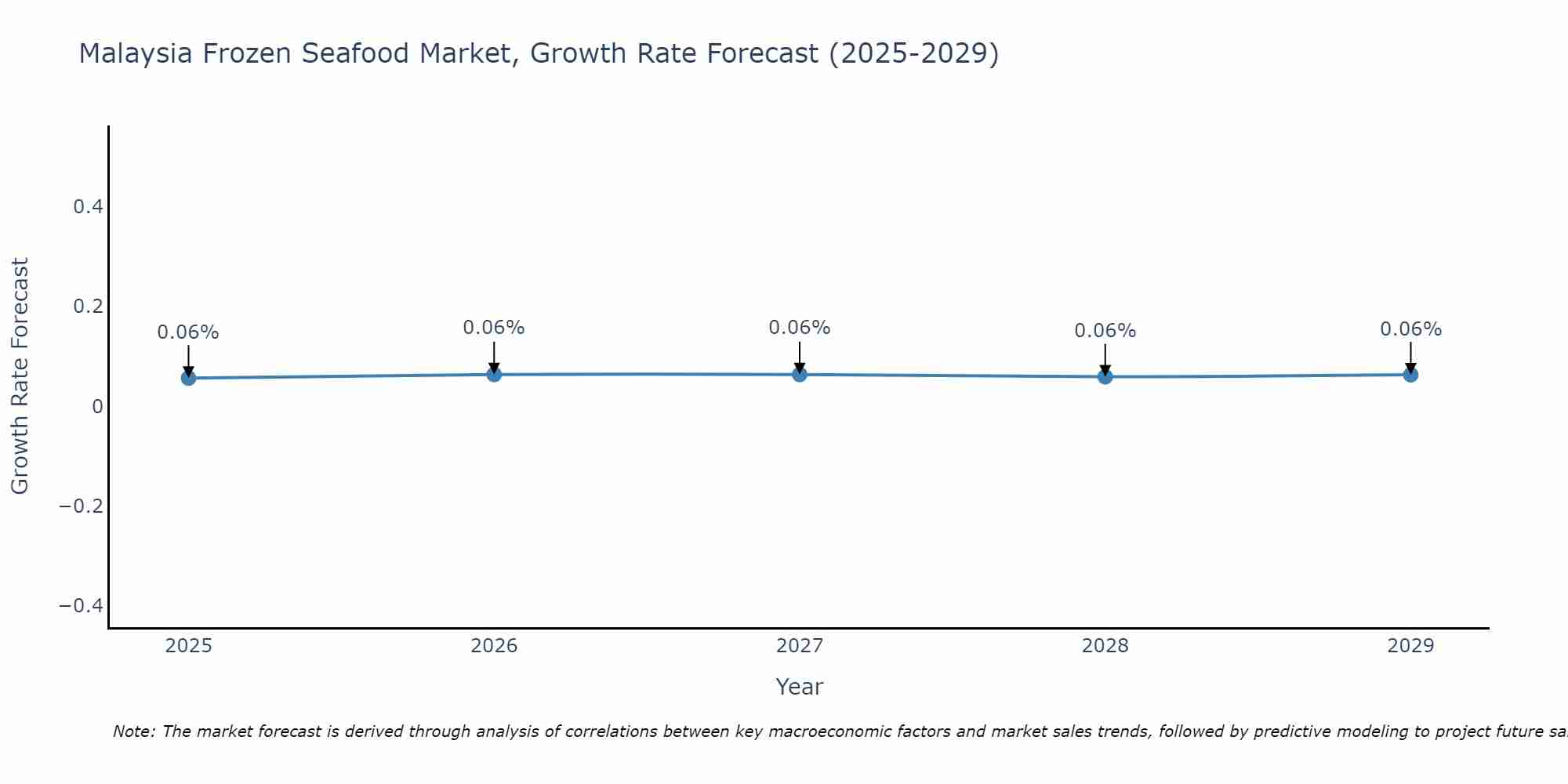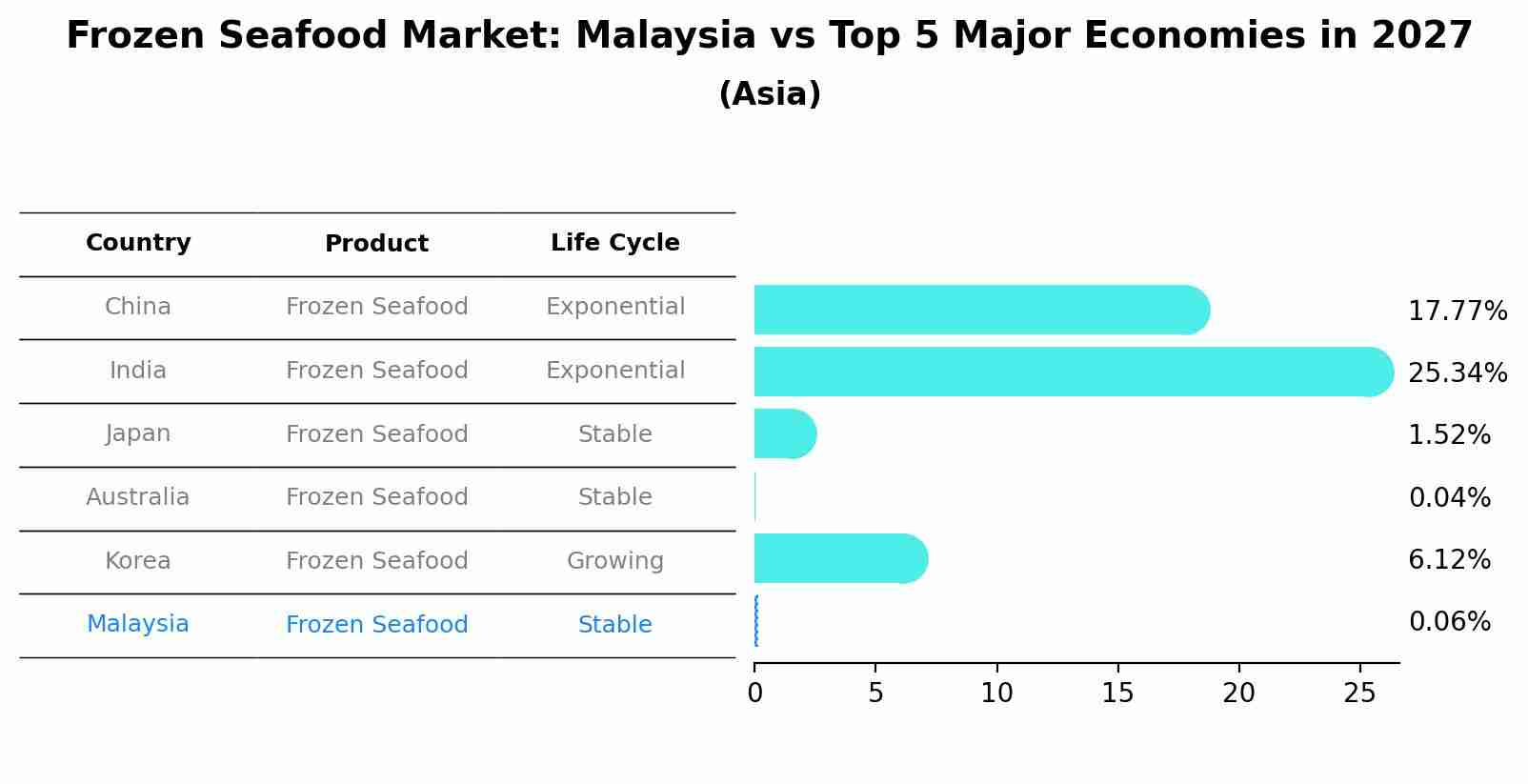Malaysia Frozen Seafood Market (2025-2031) Outlook | Growth, Value, Analysis, Forecast, Revenue, Industry, Share, Size, Trends & Companies
| Product Code: ETC386666 | Publication Date: Aug 2022 | Updated Date: Apr 2025 | Product Type: Market Research Report | |
| Publisher: 6Wresearch | No. of Pages: 75 | No. of Figures: 35 | No. of Tables: 20 | |
Malaysia Frozen Seafood Market Size Growth Rate
The Malaysia Frozen Seafood Market is projected to witness mixed growth rate patterns during 2025 to 2029. Starting at 0.06% in 2025, the market peaks at 0.06% in 2027, and settles at 0.06% by 2029.

Frozen Seafood Market: Malaysia vs Top 5 Major Economies in 2027 (Asia)
By 2027, Malaysia's Frozen Seafood market is forecasted to achieve a stable growth rate of 0.06%, with China leading the Asia region, followed by India, Japan, Australia and South Korea.

Malaysia Frozen Seafood Market Synopsis
The frozen seafood market in Malaysia is thriving, driven by consumer preferences for convenient and high-quality seafood products. This market encompasses a wide range of frozen seafood items, including fish, molluscs, and various other marine delicacies. Factors such as busy lifestyles, improved freezing technologies, and the desire for year-round access to seafood have contributed to the market`s expansion. As consumers become more health-conscious and seek diverse culinary experiences, the outlook for the Malaysia frozen seafood market remains positive.
Drivers of the Market
The frozen seafood market in Malaysia continues to grow, driven by several key factors. A significant driver is the increasing consumer preference for frozen seafood due to its convenience, longer shelf life, and year-round availability. Moreover, the variety of seafood products available in frozen form, including shrimp, squid, and various fish species, caters to diverse culinary preferences. Improved freezing and packaging technologies ensure the quality and taste of frozen seafood are preserved, further boosting market growth. The COVID-19 pandemic has also accelerated the adoption of frozen seafood as consumers stock up on essential items. As a result, the Malaysia frozen seafood market is expected to maintain its positive trajectory in the coming years.
Challenges of the Market
The frozen seafood market in Malaysia is likely to experience sustained growth. Consumer demand for a variety of seafood options, including shrimp, squid, and various fish species, drives this trend. The freezing process ensures extended shelf life and convenient storage. Nonetheless, the market will need to address issues related to sustainability and responsible sourcing of seafood products. Additionally, maintaining product quality and safety standards will be paramount.
COVID-19 Impact on the Market
The frozen seafood market in Malaysia experienced mixed effects during the COVID-19 pandemic. Initially, there was a surge in demand for frozen seafood products, driven by consumers` desire for long-lasting and easily accessible food options. However, the market faced supply chain disruptions due to lockdowns and logistical challenges. As the pandemic continued, economic uncertainties impacted consumer spending, leading to fluctuations in demand. To navigate the post-pandemic landscape successfully, businesses in the frozen seafood sector should prioritize supply chain resilience, explore e-commerce opportunities, and focus on product innovation to meet changing consumer preferences.
Key Players in the Market
The frozen seafood market in Malaysia is poised for steady growth as consumers seek convenient and hygienic seafood options. Prominent companies like Seafood Malaysia, Starfish Seafoods, and Borneo Seafood are expected to remain key players, emphasizing sustainability and sourcing practices to meet consumer expectations.
Key Highlights of the Report:
- Malaysia Frozen Seafood Market Outlook
- Market Size of Malaysia Frozen Seafood Market, 2024
- Forecast of Malaysia Frozen Seafood Market, 2031
- Historical Data and Forecast of Malaysia Frozen Seafood Revenues & Volume for the Period 2021-2031
- Malaysia Frozen Seafood Market Trend Evolution
- Malaysia Frozen Seafood Market Drivers and Challenges
- Malaysia Frozen Seafood Price Trends
- Malaysia Frozen Seafood Porter's Five Forces
- Malaysia Frozen Seafood Industry Life Cycle
- Historical Data and Forecast of Malaysia Frozen Seafood Market Revenues & Volume By Nature for the Period 2021-2031
- Historical Data and Forecast of Malaysia Frozen Seafood Market Revenues & Volume By Organic Frozen Seafood for the Period 2021-2031
- Historical Data and Forecast of Malaysia Frozen Seafood Market Revenues & Volume By Conventional Frozen Seafood for the Period 2021-2031
- Historical Data and Forecast of Malaysia Frozen Seafood Market Revenues & Volume By Form for the Period 2021-2031
- Historical Data and Forecast of Malaysia Frozen Seafood Market Revenues & Volume By Raw Frozen Seafood for the Period 2021-2031
- Historical Data and Forecast of Malaysia Frozen Seafood Market Revenues & Volume By Processed Frozen Seafood for the Period 2021-2031
- Historical Data and Forecast of Malaysia Frozen Seafood Market Revenues & Volume By End Use for the Period 2021-2031
- Historical Data and Forecast of Malaysia Frozen Seafood Market Revenues & Volume By Food Processing Industry for the Period 2021-2031
- Historical Data and Forecast of Malaysia Frozen Seafood Market Revenues & Volume By Food Service Industry for the Period 2021-2031
- Historical Data and Forecast of Malaysia Frozen Seafood Market Revenues & Volume By Retail/Household for the Period 2021-2031
- Historical Data and Forecast of Malaysia Frozen Seafood Market Revenues & Volume By Product Type for the Period 2021-2031
- Historical Data and Forecast of Malaysia Frozen Seafood Market Revenues & Volume By Frozen Fish for the Period 2021-2031
- Historical Data and Forecast of Malaysia Frozen Seafood Market Revenues & Volume By Frozen Molluscs for the Period 2021-2031
- Historical Data and Forecast of Malaysia Frozen Seafood Market Revenues & Volume By Frozen Crustaceans for the Period 2021-2031
- Historical Data and Forecast of Malaysia Frozen Seafood Market Revenues & Volume By Distribution Channel for the Period 2021-2031
- Historical Data and Forecast of Malaysia Frozen Seafood Market Revenues & Volume By Business to Business for the Period 2021-2031
- Historical Data and Forecast of Malaysia Frozen Seafood Market Revenues & Volume By Business to Consumer for the Period 2021-2031
- Historical Data and Forecast of Malaysia Frozen Seafood Market Revenues & Volume By E-Commerce/Online Stores for the Period 2021-2031
- Malaysia Frozen Seafood Import Export Trade Statistics
- Market Opportunity Assessment By Nature
- Market Opportunity Assessment By Form
- Market Opportunity Assessment By End Use
- Market Opportunity Assessment By Product Type
- Market Opportunity Assessment By Distribution Channel
- Malaysia Frozen Seafood Top Companies Market Share
- Malaysia Frozen Seafood Competitive Benchmarking By Technical and Operational Parameters
- Malaysia Frozen Seafood Company Profiles
- Malaysia Frozen Seafood Key Strategic Recommendations
Frequently Asked Questions About the Market Study (FAQs):
- Single User License$ 1,995
- Department License$ 2,400
- Site License$ 3,120
- Global License$ 3,795
Search
Related Reports
- Middle East OLED Market (2025-2031) | Outlook, Forecast, Revenue, Growth, Companies, Analysis, Industry, Share, Trends, Value & Size
- Saudi Arabia Plant Maintenance Market (2025-2031) | Industry, Size, Growth, Revenue, Value, Companies, Forecast, Analysis, Share & Trends
- Taiwan Electric Truck Market (2025-2031) | Outlook, Industry, Revenue, Size, Forecast, Growth, Analysis, Share, Companies, Value & Trends
- South Korea Electric Bus Market (2025-2031) | Outlook, Industry, Companies, Analysis, Size, Revenue, Value, Forecast, Trends, Growth & Share
- Japan Automotive Headrest Market (2025-2031)
- Italy Automotive Headrest Market (2025-2031)
- Indonesia Automotive Headrest Market (2025-2031)
- India Automotive Headrest Market (2025-2031)
- Germany Automotive Headrest Market (2025-2031)
- France Automotive Headrest Market (2025-2031)
Industry Events and Analyst Meet
Our Clients
Whitepaper
- Middle East & Africa Commercial Security Market Click here to view more.
- Middle East & Africa Fire Safety Systems & Equipment Market Click here to view more.
- GCC Drone Market Click here to view more.
- Middle East Lighting Fixture Market Click here to view more.
- GCC Physical & Perimeter Security Market Click here to view more.
6WResearch In News
- Doha a strategic location for EV manufacturing hub: IPA Qatar
- Demand for luxury TVs surging in the GCC, says Samsung
- Empowering Growth: The Thriving Journey of Bangladesh’s Cable Industry
- Demand for luxury TVs surging in the GCC, says Samsung
- Video call with a traditional healer? Once unthinkable, it’s now common in South Africa
- Intelligent Buildings To Smooth GCC’s Path To Net Zero













